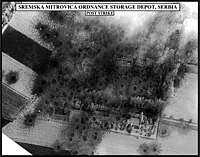Airstrike: Difference between revisions
Corentinoger (talk | contribs) m link to attack chopper |
|||
| Line 17: | Line 17: | ||
=="Broken Arrow"== |
=="Broken Arrow"== |
||
The United States military code word for calling in all available aircraft for an air strike to support a ground unit facing imminent defeat in a battle was "Broken Arrow". |
The United States military code word for calling in all available aircraft for an air strike to support a ground unit facing imminent defeat in a battle was "[[Broken Arrow]]". |
||
The code has been depicted during the movie ''[[We Were Soldiers]]'', depicting the battle at [[Battle of Ia Drang|Landing Zone X-Ray]] in the [[Ia Drang Valley]] during the [[Vietnam War]]. |
The code has been depicted during the movie ''[[We Were Soldiers]]'', depicting the battle at [[Battle of Ia Drang|Landing Zone X-Ray]] in the [[Ia Drang Valley]] during the [[Vietnam War]]. |
||
Revision as of 08:21, 27 October 2009
This article needs additional citations for verification. (July 2008) |

An air strike[1] is a military strike by air forces or other military aviation assets against either a suspected or a confirmed enemy ground position. Air strikes are commonly delivered from aircraft such as bombers, ground attack aircraft, strike fighters, and Attack helicopters. Weapons used in an airstrike can range from machine gun bullets, missiles, to various types of bombs. Air strikes are sometimes initiated in strategic bombings, but the term generally refers to tactical intervention by airpower on the battlefield.
Air strikes may be followed by artillery, armor, or infantry assaults, dependent on the military situation at hand. Air strikes are commonly used when ground attacks are ineffective, when ground forces need to be used in conjunction with close air support, or when public opinion in the nation or around the world would not support a ground attack[citation needed].
Air strikes are controlled by trained observers, often translating the requests of ground troops. The coordination and authorization of air strikes is carried out at command levels to ensure minimal "collateral damage" or "fratricidal fire".[citation needed]
History

On November 1, 1911, Italian aviator Second Lieutenant Giulio Gavotti dropped four bombs on two Turkish-held oases in Libya, carrying out the world's first air strikes as part of the Italo-Turkish War.[2]
One of the first examples of an Allied use of an airstrike during World War I was at the Battle of Neuve Chapelle in 1915 when the RFC dropped bombs on German rail communications.
"Broken Arrow"
The United States military code word for calling in all available aircraft for an air strike to support a ground unit facing imminent defeat in a battle was "Broken Arrow".
The code has been depicted during the movie We Were Soldiers, depicting the battle at Landing Zone X-Ray in the Ia Drang Valley during the Vietnam War.
Collateral damage
In any air strike, there is a risk of injuring, killing, or destroying non-combatants, allies or non-military buildings. This is called collateral damage.[3]
Collateral damage can be advantageous by damaging nearby enemy troops and installations. The negative side effects to collateral damage may include the infliction of damage to civilian facilities and accidental injury of friendly troops near the target.
The amount of civilian collateral damage caused by air strikes has decreased dramatically since its peak during the World War II era, when air strikes were carried out with 'dumb' bombs - bombs without any guidance systems. The strategy was to use large numbers of bombers and bombs in the hope that some of the bombs that were dropped struck the intended target.
There have been claims that lately, with the increased availability of precision-guided missiles and smart bombs by the military in the modern era, recent conflicts such as Operation Desert Storm and the 2003 Invasion of Iraq have seen decreased civilian collateral damage as compared to previous wars, such as the Allied incendiary bombing raids on Dresden, the German bombing of Coventry during the Blitz, and the American air strikes on the Japanese mainland during the Second World War.
See also
References
- ^ air strike- DOD Dictionary of Military and Associated Terms
- ^ U.S. Centennial of Flight Commission: Aviation at the Start of the First World War
- ^ "Air Force Law Review". Jefferson D. Reynolds. Winter, 2005.
{{cite web}}: Check date values in:|date=(help)
